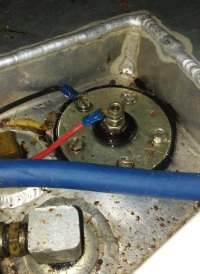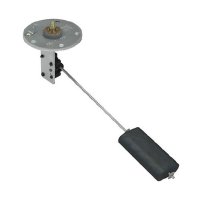I’ve seen specs that the fuel tank should hold anywhere from 19 to 21 gallons. Let’s call it 20. I pulled into a marina on my way down the Tennessee river a couple days back with the fuel gauge at about 1/8 full. I don’t have 100% confidence and it’s accuracy, but let’s start there. The attendant pumped 21 gallons into the tank without fuel coming all the way up the delivery port!
The shoe gauge red full for the next 70 miles, so I figured it was stuck in the full position. Based on known fuel consumption, I decided to add 5 gallons from a jerrycan on deck. After another 10 or 15 miles, the gauge was still reading full, so I decided to visually inspect the level in the tank. I gingerly undid one of the 6 screws for the fuel gauge sender unit assembly and fuel started welling up out of the screw hole. So, my tank is still filled higher than the inset level of that sender mounting. The bad thing is, that ever since that Marina fell, I have had some diesel in my bilges. I would think that the system does not have any overflow vents and relies on the filler spout for that. Am I wrong?
The shoe gauge red full for the next 70 miles, so I figured it was stuck in the full position. Based on known fuel consumption, I decided to add 5 gallons from a jerrycan on deck. After another 10 or 15 miles, the gauge was still reading full, so I decided to visually inspect the level in the tank. I gingerly undid one of the 6 screws for the fuel gauge sender unit assembly and fuel started welling up out of the screw hole. So, my tank is still filled higher than the inset level of that sender mounting. The bad thing is, that ever since that Marina fell, I have had some diesel in my bilges. I would think that the system does not have any overflow vents and relies on the filler spout for that. Am I wrong?






